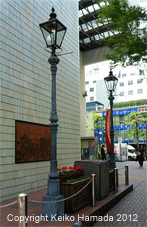Gaslight Memorial Yokohama

Public Art: Gaslight Memorial
Also Known As : Japan’s First Gaslight Memorial
Designer: © Naoyuki Kuniyoshi
Description: This memorial, which includes an etching and two replica gas lamps, is in honor of Japan’s first gaslights which were installed by Kaemon Takashima’s gas company (ref. no. 3.23) in 1872 and began illuminating the streets of Bashamichi. Takashima placed about ten gaslights along the street from Bashamichi to Honmachidori (approximately 600 meters) . The original gaslights are believed to have been destroyed in the Great Kanto Earthquake of 1923.
Date Unveiled:
Location: The Gaslight memorial is located outside Kannai Hall, Bashamichi, Yokohama, Japan.
Inscription: Translated
Yokohama has become a gateway to Western culture since its opening in 1859. There are many things spreading nationwide starting from the horse carriageway.
In 1872, gas lamps were installed and lighted in Bashamichi / Honcho street etc. by Takashima Kaemon ‘s “Nippon Gas company”, which became the first gas light in Japan. It is said that pillars were imported from Glasgow City, Scotland, and the lamps were manufactured by Japanese craftsmen.
We celebrated the construction of Yokohama Municipal Citizens’ Cultural Hall (Kannai Hall) new construction and restored and installed gas lamps based on the model at that time.
The relief on the wall is a copy of the postcard stored in the Yokohama Port Opening Materials Museum, and it is a horse-drawn road in the late Meiji era.
Showa 61 September 27 Baba Road Shopping District Cooperative Association
Acknowledgements: Thank you to Keiko Hamada for kindly providing the photos.
Things You May Not Know:
Kaemon Takashima was the first civilian to personally meet Emperor Meiji, who presented him with three sets of silver cups in recognition of his distinguished services. Takashima founded Aichi Cement Corporation and was president of Tokyo Street Railway.
The original 1872 lamp posts were imported from Glasgow while other parts were made in Japan.
Bashamichi is now lined with gas lamps brought in from the British Parliament, Victoria Tower, Trafalgar Square and Sheffield Park.
A Little Bit Of Yokohama History :
Prior to 1858 Japan was closed off to the rest of the world, having a strict isolation policy that limited its trade with foreign countries to virtually zero. Under its Sakoku policy (which means “locking the country”) from 1633 until 1853 no foreigner could enter Japan, nor could any Japanese leave the country without the penalty of death. However, there were a few exceptions to the rules with mainly the Dutch and Chinese traders.
After several failed attempts by the US government to broker an open trade agreement with Japan, Commodore Matthew Perry decided to give it a try. On July the 8th, 1853, Perry anchored in Uraga Harbour on a black hulled steam frigate (and several other ships in tow) near Edo, which is now modern Tokyo. The Tokugawa Shogunate (shoguns who ruled during this time) basically told him to go away and try his luck in Nagasaki, the only Japanese port open to foreigners.
Instead of taking their advice, Perry ordered his ships to head towards the capital Edo and position their guns directly at the city of Uraga. Despite numerous requests for them to leave, Perry stood his ground and demanded he be allowed present a letter from US President Millard Fillmore, which basically requested the rights for the US to trade with Japan. Once they agreed to receive the letter, Perry left, promising to return shortly for an answer. Which he did, this time with double the ships and firepower.
Much to everyone’s surprise, the Shogunate had agreed to all of President Fillmore’s demands. On March 31st, 1854 the Convention of Kanagawa (Treaty of Peace and Amity) was signed. The treaty opened the Japanese ports of Shimoda and Hakodate to United States trade and guaranteed the safety of shipwrecked U.S. sailors.
The signing of the treaty would inevitably change Japan and its culture forever.
The opening of the Yokohama Port in 1859 marked the start of an industrial boom in Japan and the westernization of a nation.
Just a small correction: Glasgow is in Scotland, not England. Scotland and England are two of the three parts of Great Britain. The third part is Wales.
Thanks Bruce, all fixed.